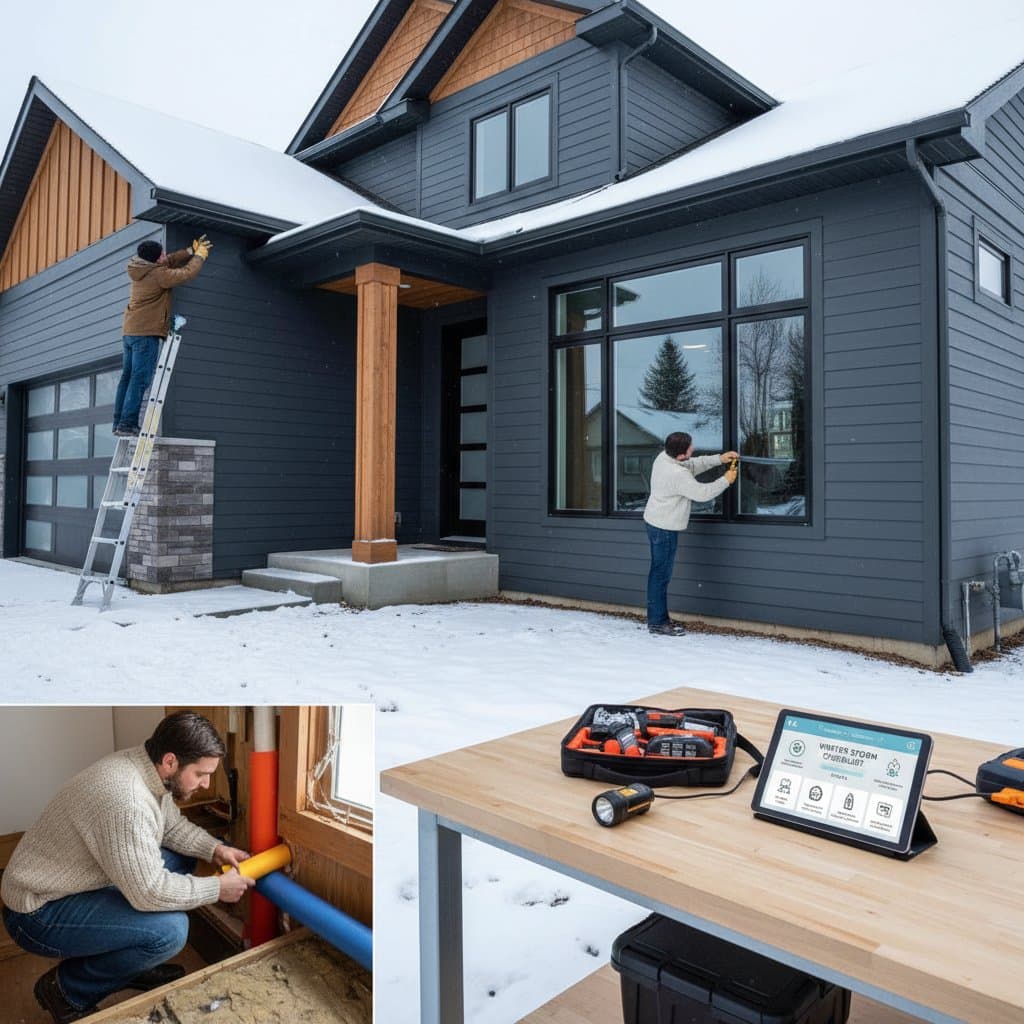Safeguard Your Home from Winter Storm Damage
Winter storms can inflict significant harm, from frozen pipes and leaking roofs to accumulated snow against exterior walls. Such issues often lead to repair bills in the thousands. Proactive measures taken now can avert these problems, ensuring your family remains comfortable and secure.
A structured weekend checklist provides an effective starting point. These steps focus on insulation, inspections, and emergency readiness to minimize risks and costs.
Essential Preparation Checklist
- Insulate exposed pipes and maintain indoor temperatures above 55 degrees Fahrenheit.
- Examine roofs, gutters, and siding for vulnerabilities prior to storms.
- Seal gaps around doors, windows, and vents to conserve energy.
- Trim overhanging branches and clear drainage paths to avoid flooding.
- Assemble backup options for power and heating during outages.
- Test safety devices like smoke and carbon monoxide alarms.
- Document your property's condition for insurance records.
These actions form the foundation of winter readiness. The following sections detail how to implement them effectively.
Protect Plumbing Systems from Freezing
Frozen pipes rank among the leading causes of winter water damage, with burst repairs frequently surpassing $1,000. Prevention centers on maintaining consistent warmth in water lines to inhibit ice formation.
Insulate Vulnerable Pipes
Prioritize pipes located in unheated spaces, such as basements, crawl spaces, and garages. Apply foam pipe insulation, available for approximately $2 per six-foot section. In regions with severe cold, supplement with heat tape connected to a grounded electrical outlet. This approach delivers reliable protection at minimal expense.
Maintain Water Flow
During anticipated cold snaps, allow a steady trickle from faucets adjacent to exterior walls. This minor water usage prevents freezing far better than facing a rupture. Set the thermostat to at least 55 degrees Fahrenheit, even during absences, to sustain adequate temperatures across the home.
Eliminate Drafts and Heat Loss
Subtle gaps allow warm air to escape, creating discomfort and inflating energy costs. Addressing these leaks enhances efficiency and livability.
Inspect Doors and Windows
Detect drafts by holding a lit candle or incense near frames and edges; a flickering flame indicates air movement. Install adhesive weatherstripping or door sweeps, priced at $10 to $20 per door, to seal entry points. For windows, apply clear plastic film kits that tighten with heat from a hair dryer; these solutions prove both affordable and efficient.
Evaluate Attic and Basement Insulation
Inadequate insulation permits heat to dissipate through roofs or floors. Conduct a visual assessment to identify needs. Install fiberglass batt insulation at $1.50 to $2.50 per square foot, which can lower heating expenses by up to 20 percent. Visible attic joists signal insufficient coverage requiring immediate attention.
Prepare for Power Outages and Ice Accumulation
Storms frequently disrupt electricity through fallen lines or heavy ice. Advance planning maintains safety and warmth without reliance on the grid.
Secure Backup Power and Heating
Portable generators begin at $500, while standby units that activate automatically range from $2,500 to $6,000 installed. For modest investments, acquire battery-operated lanterns and flashlights. Refrain from indoor use of gas appliances like stoves or grills due to carbon monoxide risks.
Space heaters fueled by kerosene or propane offer targeted warmth when ventilation remains open. Select units equipped with auto-shutoff features. Install carbon monoxide detectors on every level for $25 to $50 each to monitor air quality.
Maintain Trees and Drainage
Overhanging limbs weighted by snow pose threats to structures and vehicles. Trim branches extending over roofs or driveways; professional services cost $200 to $600, though basic pruning with a pole saw suits smaller tasks. Remove debris from drains to prevent ice-induced backups and flooding.
Manage Snow and Ice Buildup
Accumulated snow exerts pressure on roofs and siding, potentially causing structural failure or water intrusion. Regular removal mitigates these dangers.
Clear Snow from Key Areas
Acquire a durable snow shovel or roof rake for $30 to $60. Post-storm, remove accumulations from driveways, paths, and eaves to avert ice dams and ensure accessible escapes. This routine preserves integrity and safety.
For roof ice, apply calcium chloride pellets over rock salt alternatives; the former harms shingles and plants less. Encase pellets in nylon stockings and position them across the eave line to form drainage channels.
Address Frozen Gutters
Avoid chiseling ice from gutters, as this damages components. Employ a hair dryer or install heat cables for gradual thawing. Professional intervention ensures safe resolution for stubborn blockages.
Inspect and Maintain Indoor Systems
Heating and safety equipment demand pre-winter evaluation to function reliably during peak demand.
Service Heating Equipment
Arrange a furnace inspection for $100 to $200 if not recently performed. Replace filters and clean vents to optimize performance. For fireplaces, schedule chimney cleaning at $125 to $250 to eliminate creosote and reduce fire hazards.
Verify Smoke and Carbon Monoxide Alarms
Test alarms monthly by pressing the button; replace batteries annually or as indicated. Position smoke detectors in bedrooms and hallways, carbon monoxide units near sleeping areas. Functional devices provide early warnings, potentially saving lives during outages or malfunctions.
Implement Expert Strategies
- Develop a phased checklist, addressing one zone per weekend for steady progress.
- Monitor forecasts to secure loose outdoor items ahead of storms.
- Assemble an emergency kit with water, shelf-stable foods, blankets, and medical supplies.
- Photograph exterior features pre-winter for insurance documentation.
- Engage licensed experts for electrical, roofing, or structural concerns.
Sustain Long-Term Protection
Ongoing vigilance extends the benefits of initial preparations. Post-storm, survey for dislodged shingles, siding cracks, or flashing shifts. Prompt snow clearance prevents refreezing and escalation.
Invested effort in these measures yields substantial returns in durability and tranquility. Your home emerges resilient against winter's challenges, securing both assets and well-being.
